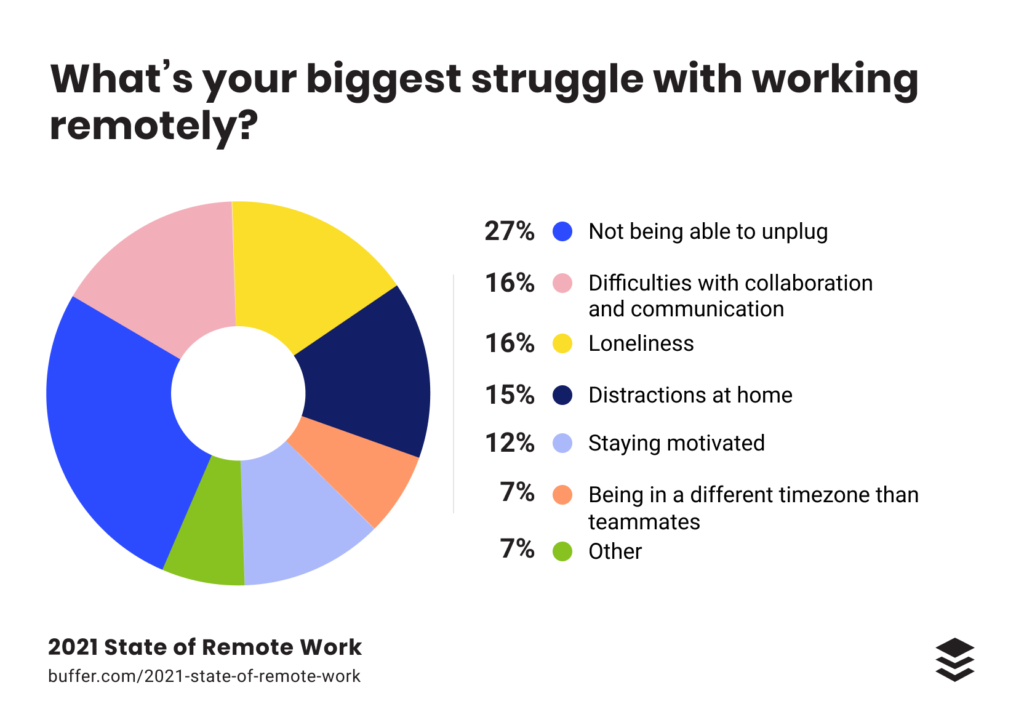From luxurious break rooms to fun team outings, employers have historically invested a lot in providing ways for their people to socialize. That is: until our working world moved from our offices to our homes.
But offering opportunities to connect is still important—arguably, it’s more essential than ever. Buffer’s 2021 State of Remote Work report found that two of the top three biggest struggles remote workers face were loneliness and difficulties with collaboration and communication.

The good news is, all these digital tools that are helping dispersed teams work more effectively can offer more ways for teammates to connect—if you know how to use them. Here are some powerful ways I’ve seen remote companies tackle team bonding, most of which are simple enough you could start implementing them today.
1. Make It Easy to Learn About Each Other
For many people, the worst part of socializing is the small talk required to get to know the basics about someone and find points of connection. Good news: There are plenty of ways to help employees get over that hurdle.
This could be as simple as creating an “introductions” Slack channel where every new employee shares a few bullet points about themselves (ask current employees to share as well so you have a full directory). Or, make better use of your company chat profiles by including custom fields in addition to the basics of your title and location, encouraging employees to share everything from fun hobbies to favorite TV shows. This can help spark individual conversations as employees discover commonalities.
2. Use Breaks Productively
It turns out that employees spend far longer on breaks than their employers think—a recent study my company conducted found that workers take an average of 2.7 hours of breaks a day. Instead of cracking down on that (a fast track to burnout and resentment), why not try turning it into an opportunity for people to have some downtime together?
For instance, allow your employees to expense lunches or coffees they have while video-conferencing with a new co-worker. (Tools like Donut can randomly match employees for this if you think they’ll need a little nudge.) Or, offer to comp the cost of virtual games your employees want to play together, since gaming has been shown to boost work relationships and general satisfaction. Encourage chance social encounters with one of the few tools you have as an employer: the budget.
3. Create Smaller Group Gatherings
I’ve seen many companies in the past year plan massive virtual social events to bring people together—but with so many people on one video chat, it can be hard to actually get to know anyone.
In order to encourage some actual virtual bonding, find opportunities for smaller group gatherings. This could be as simple as using the breakout rooms feature available on many video call platforms—Buffer, for example, carves out 5-10 minutes at the end of most of their all-hands for small breakout chats of 3-5 people, even providing conversation starters. (Tools like Gatherround can also pair teammates for quick one-on-one convos using creative icebreakers.) Or, instead of planning one big social event a month, plan several and encourage employees to pick the one that appeals most—this will bring smaller groups of like-minded folks together.
4. Encourage Cross-Team Sharing
One of the hardest things about remote work is getting to know people who aren’t on your immediate team. Finding ways to combat that can be a powerful way to make everyone feel unified as a company and help employees find more people they connect with.
One way to do this is by changing up how you do your weekly meetings. Many teams have some form of weekly meeting to check in on what folks have been working on. Instead of keeping this siloed to your immediate department, why not mix up groups to encourage co-workers who don’t work together often to bond? Or, try creating an open virtual co-working block and huddle spaces every day or week, where anyone can join, share a bit about what they’re working on that day, quietly work together for motivation, and then have a few minutes of open chatting at the end as a reward.
5. Get a Peek Into Each Others’ Lives
When everyone is in the office together, it’s easy to pick up on little hints about your teammates’ lives. You hear what they got up to the night before in the elevator or while grabbing coffee. They share their best stories during weekly happy hour. Even seeing how they choose to decorate their desk or cubicle can tell you something about them. Finding ways to recreate these small, authentic windows into each others’ lives is a powerful way to build connection.
A simple way to do this is to stop encouraging employees to use consistent video backgrounds, and instead let teammates see what’s really going on in their homes, sharing pets, children, wall art, and all. If you want a more structured approach, I’ve heard of a company that does “Photo Friday” in their group chat, giving a prompt each week and encouraging everyone to share a photo and the story behind it (e.g., a photo from your favorite vacation, your worst haircut, the best meal you ate recently).
6. Celebrate Wins, Big and Small
I’ve talked about the value of recognition before, but it bears repeating. Regularly recognizing the achievements of your team members can be a powerful motivator—and doing so in a team setting can be a great way to help everyone learn a little more about each other.
So create a “wins” or “recognition” channel in your company chat, and encourage teammates to share something they’re proud of, or even compliment the work of other colleagues. For even deeper team bonding, encourage people to share personal wins, too—like running a 5K, closing on a new house, watching their baby’s first steps, and the like. This can help build a culture of folks who support each other—in and out of the virtual office.





